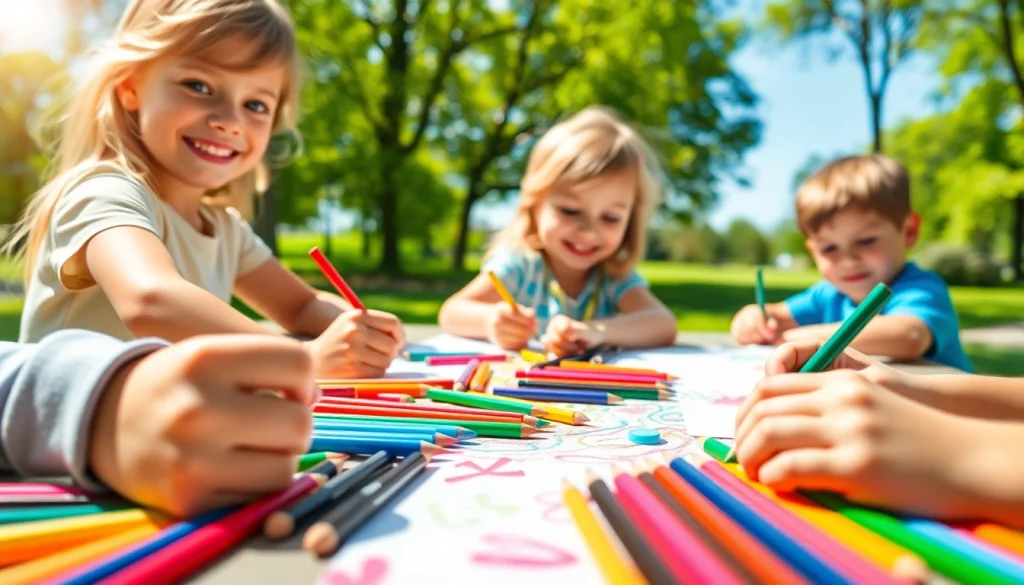The Benefits of Kids Colouring Pencils
Engaging with kids colouring pencils is not just a playful pastime; it’s a fundamental part of childhood development that brings numerous benefits. This article explores how these simple art tools help shape and nurture young minds, fostering essential skills that extend beyond the realm of creativity. From enhancing motor skills to building confidence, kids’ colouring pencils offer a versatile platform for artistic expression and cognitive growth.
Enhancing Motor Skills
One of the primary benefits of using colouring pencils is their ability to enhance fine motor skills in children. The act of grasping, controlling, and applying pressure with pencils requires coordination and strength from the fingers and hands. As children colour, they develop the dexterity needed for various tasks such as writing, tying shoelaces, and using utensils. This skill development is crucial during the early years when children are mastering their bodily control.
Research shows that activities involving hand-eye coordination, like colouring, lay a foundation for future learning, particularly in literacy and numeracy. By practising these skills through colouring, children naturally improve their ability to perform intricate tasks, which is essential for their overall development.
Encouraging Creativity
Creativity is a vital part of human expression and cognitive development. Kids’ colouring pencils provide an outlet for children to unleash their imagination. As children choose colours, create patterns, and experiment with different techniques, they engage in creative thinking that can carry over into other areas of their lives. This creativity boosts problem-solving skills and can help children think outside the box as they navigate challenges in school and beyond.
Moreover, colouring allows for personal expression. Each child’s art is unique, reflecting their thoughts, feelings, and personality. This personal touch encourages a sense of ownership and pride in their work, fostering a love for creativity that can last a lifetime.
Building Confidence in Young Artists
Completing a colouring project can instil a sense of accomplishment in young artists. As they see the transformation from a blank page to a vibrant piece of art, they experience a boost in self-esteem. This is particularly important in a world where children are often assessed by their academic performance. Colouring provides a safe space for experimentation without fear of judgment or failure, allowing children to explore their capabilities freely.
Encouragement and positive feedback on their artwork from parents and educators further enhance this sense of accomplishment, reinforcing their ability to create and succeed. This confidence can then translate into other areas of their lives, improving their readiness to tackle new challenges.
Choosing the Right Kids Colouring Pencils
Selecting the appropriate colouring pencils for kids involves understanding the different types available, considering age appropriateness, and exploring eco-friendly options. Making informed decisions can lead to enriched experiences during colouring sessions.
Different Types of Colouring Pencils Explained
When it comes to kids’ colouring pencils, there are several types to consider:
- Coloured Pencils: These are standard pencils filled with pigmented cores. They are versatile and can create both bold and subtle shades, making them ideal for various styles of colouring.
- Watercolour Pencils: These pencils can be used dry like regular coloured pencils or wet to create a watercolour effect. When combined with water, the pigments dissolve, allowing for blending and softer edges.
- Gel Pencils: Known for their vibrant colours and smooth application, gel pencils provide a different colouring experience. They are great for adding highlights and sparkling details which appeal to older kids.
- Pastel Pencils: Offering softer, blendable colours, pastel pencils can give a more painter-like effect. They are particularly suited for children who enjoy blending and layering their colours.
Considerations for Age Appropriateness
When selecting colouring pencils, age appropriateness is crucial. For younger children, chunky and triangular-shaped pencils are often the best choice, as they are easier to hold and manipulate. As children grow older and develop more refined motor skills, they can transition to regular-sized pencils, allowing for more detailed work.
It is also important to consider the safety of the materials used. Ensuring that the pencils are non-toxic and free from harmful substances is paramount when purchasing art supplies for children. Checking for certifications on the packaging can provide peace of mind.
Eco-Friendly Options Available
As sustainability becomes increasingly important, many brands now offer eco-friendly colouring pencil options. These may be made from recycled materials, natural woods, or biodegradable packaging. Opting for such products not only supports the environment but also teaches children the importance of eco-conscious choices from a young age.
Furthermore, choosing non-toxic and organic pigments can minimize exposure to harmful chemicals, supporting healthier art practices as children explore their creativity.
Fun Activities Using Kids Colouring Pencils
Colouring pencils can be the key to a multitude of fun and interactive activities that stimulate children’s imagination and creativity. Here are some creative activities that can maximize the joy of colouring.
Themed Colouring Pages for Kids
Themed colouring pages can add an extra layer of excitement to colouring sessions. Themes can range from animals, space explorations, and underwater adventures to seasonal themes such as holidays or nature. By providing a narrative or context to the colouring experience, children can engage more deeply with their artwork.
These themed pages can easily be found online or created using drawing apps, aligning with interests or educational topics children are currently exploring. For example, introducing marine life through colourful illustrations can be paired with lessons about ocean ecosystems.
Collaborative Art Projects
Collaboration enhances social skills, and what better way to foster teamwork than through group art projects? Children can set up large sheets of paper, mural-style, where they can work together using their colouring pencils. This not only amplifies creativity but also promotes communication and sharing.
Organizing themed collaborative projects, such as creating a community mural or decorating a classroom wall, can create a sense of ownership and pride in their collective effort. Such projects also serve to strengthen friendships and build community amongst peers.
Seasonal Celebrations and Art
Utilizing colouring pencils in seasonal celebrations can make festivities even more enjoyable for kids. Creating decorations, greeting cards, or gift tags using their artistic skills brings an element of personal touch to holiday traditions. Themes can range from Halloween masks, Christmas ornaments, to Springtime flowers, allowing children to express themselves creatively while celebrating.
For instance, during the Halloween season, kids can colour spooky designs which can then be used as decorations around the house. This approach not only celebrates the season but also integrates art into family traditions, providing lasting memories.
How to Care for Kids Colouring Pencils
To ensure that colouring pencils provide long-lasting use, it’s essential to adopt proper care and maintenance practices. Here are some tips on how to store and maintain kids’ colouring pencils effectively.
Storage Solutions for Longevity
Proper storage can significantly extend the life of colouring pencils. Keeping the pencils in a cool, dry place prevents them from becoming brittle or warped. Using pencil cases or storage containers with compartments allows for organized storage, making it easier for kids to find their favourite colours.
Consider labeling storage containers or sections based on colour families or types (e.g., watercolour, gel pens) to introduce color theory or organization skills. This not only aids in maintaining the pencils but also makes art time more efficient and enjoyable.
Sharpening Techniques for Optimal Use
Sharpening pencils properly is crucial for optimal use. Using quality sharpeners specifically designed for coloured pencils ensures a clean point without breaking the core. Avoid using standard pencil sharpeners as they may not accommodate thicker pencil bases and can lead to wasted materials.
Additionally, for watercolour pencils, using a knife or a specialized sharpener may provide better results by helping the user create a finer point for detailed work. Teaching kids the correct sharpening methods fosters a sense of responsibility towards their art supplies.
Creative Recycling Ideas
When colouring pencils eventually become too short to use, rather than discarding them, consider creative recycling options. One idea is to collect the stubs and create colored pencil artwork by melting them into new shapes or using them to make DIY lollipops or crayons. Children can take part in this creative process, learning about reusing materials and sustainability.
Another engaging recycling activity involves transforming a container of old pencils into plant markers for gardening. This adds an interactive element to their planting projects and teaches them about sustainability and resourcefulness.
Involving Parents and Educators
The role of parents and educators in nurturing children’s artistic skills cannot be overstated. Collaborating with kids during their art projects creates a supportive environment that fosters creativity and exploration. Here are some ways to deepen involvement:
Creating an Inspiring Art Space
A dedicated art space can make a significant difference in a child’s motivation to create. Setting up a colorful and inviting area filled with various art materials, including kids’ colouring pencils, can stimulate their imagination. This space should be well lit, easily accessible, and stocked with a variety of papers, drawing tools, and other materials to encourage spontaneous art activities.
Incorporating natural elements or showcasing completed artwork can inspire ongoing creativity. Additionally, involving children in setting up the space can foster ownership and a desire to utilize their art area.
Encouraging Interactive Art Sessions
Interactive art sessions where parents and educators create alongside children can be immensely beneficial. This shared experience not only allows for quality time but also demonstrates that art is a valuable and enjoyable part of life. Participating in colouring challenges or themed art days can be a fantastic way to inspire children and get them excited about their creative pursuits.
In such sessions, sharing artistic techniques, discussing choices, and even failing together encourages a healthy attitude towards art and reinforces that the creative journey is just as important as the end product.
Celebrating Children’s Artwork
Recognizing and celebrating children’s artwork plays a crucial role in building their confidence and validating their creative expressions. Various methods to display their art range from home galleries to art showcases at schools or community centers, which can motivate children to continue creating.
Creating a “triumph wall” at home where children’s best pieces are displayed prominently can inspire them to persist in their artistic endeavors. Additionally, parents can engage with children to create portfolios of their work, assisting them in understanding the value of their artistic progress and efforts.


